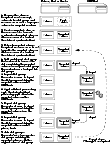|
|
< Previous | Next > |
| Product: Storage Foundation Guides | |
| Manual: Storage Foundation 4.1 FlashSnap Point-In-Time Copy Solutions Administrator's Guide | |
Implementing Off-Host Point-In-Time Copy SolutionsAs shown in Example Implementation of an Off-Host Point-In-Time Copy Solution, by accessing snapshot volumes from a lightly loaded host (shown here as the OHP host), CPU- and I/O-intensive operations for online backup and decision support are prevented from degrading the performance of the primary host that is performing the main production activity (such as running a database). Also, if you place the snapshot volumes on disks that are attached to host controllers other than those for the disks in the primary volumes, it is possible to avoid contending with the primary host for I/O resources. To implement this, paths 1 and 2 shown in the following figures should be connected to different controllers. Example Implementation of an Off-Host Point-In-Time Copy Solution Click the thumbnail above to view full-sized image. The figure Example Connectivity for Off-Host Solution Using Redundant-Loop Access gives an example of how you might achieve such connectivity using Fibre Channel technology with 4 Fibre Channel controllers in the primary host. This layout uses redundant-loop access to deal with the potential failure of any single component in the path between a system and a disk array. Example Connectivity for Off-Host Solution Using Redundant-Loop Access Click the thumbnail above to view full-sized image. Example Implementation of an Off-Host Point-In-Time Copy Solution Using a Cluster Node shows how off-host processing might be implemented in a cluster by configuring one of the cluster nodes as the OHP node. Example Implementation of an Off-Host Point-In-Time Copy Solution Using a Cluster Node Click the thumbnail above to view full-sized image. Alternatively, the OHP node could be a separate system that has a network connection to the cluster, but which is not a cluster node and is not connected to the cluster's private network. This arrangement is illustrated in Example implementation of an Off-Host Point-In-Time Copy Solution Using a Separate OHP Host. Example implementation of an Off-Host Point-In-Time Copy Solution Using a Separate OHP Host Click the thumbnail above to view full-sized image. Using VERITAS FlashSnap to implement Off-Host Processing Solutions illustrates the steps that are needed to set up the processing solution on the primary host. Disk Group Split/Join is used to split off snapshot volumes into a separate disk group that is imported on the OHP host. Using VERITAS FlashSnap to implement Off-Host Processing Solutions Click the thumbnail above to view full-sized image. Data Integrity in Volume Snapshots
A volume snapshot represents the data that exists in a volume at a given point in time. As such, VxVM does not have any knowledge of data that is cached by the overlying file system, or by applications such as databases that have files open in the file system. If the fsgen volume usage type is set on a volume that contains a VERITAS File System (VxFS), intent logging of the file system metadata ensures the internal consistency of the file system that is backed up. For other file system types, depending on the intent logging capabilities of the file system, there may potentially be inconsistencies between in-memory data and the data in the snapshot image. Choices for Snapshot ResynchronizationWhen a snapshot volume is reattached to its original volume within a shared disk group, there are two choices for resynchronizing the data in the volume:
|
| ^ Return to Top | < Previous | Next > |
| Product: Storage Foundation Guides | |
| Manual: Storage Foundation 4.1 FlashSnap Point-In-Time Copy Solutions Administrator's Guide | |
|
VERITAS Software Corporation
www.veritas.com |




